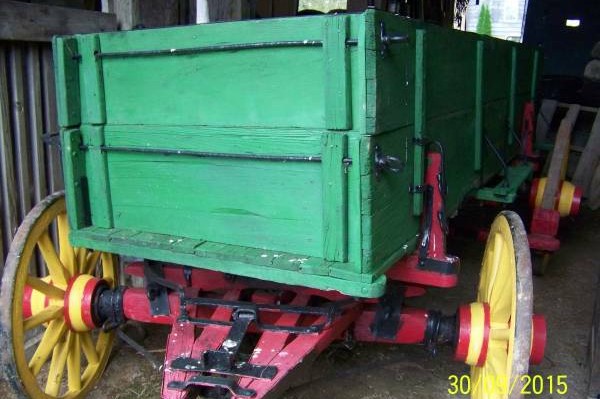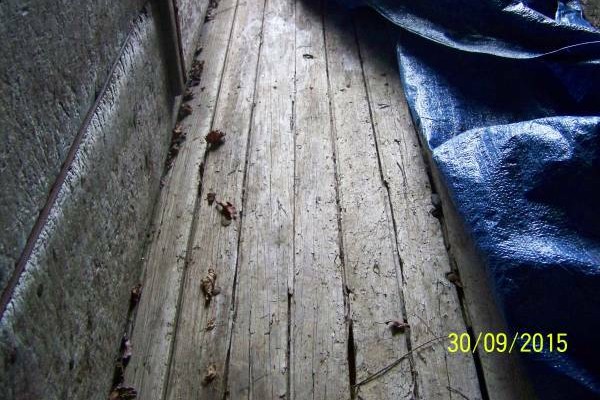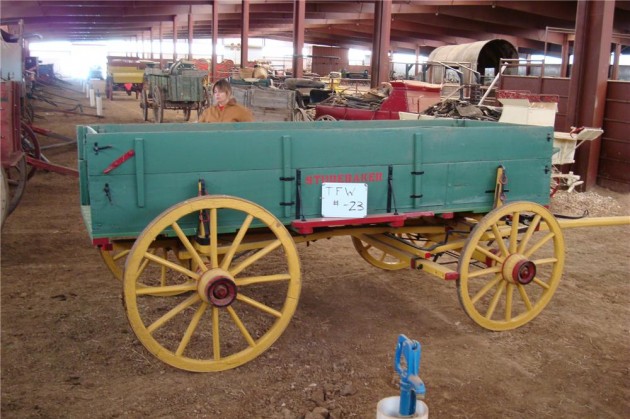Go ahead, try and argue that this isn’t an appropriate barn find! “Hildy, go get the horse and harness up, we’re headed to town!” Studebaker made wagons for over 50 years prior to getting into the car business in 1902. As Stephen Longstreet wrote in his history of Studebaker, the company built wagons with “fancy, hand-worked iron trim, the kind of courting buggy any boy and girl would be proud to be seen in.” No wonder Hildy wanted to go to town! This particular wagon is for sale in Johnson City, Tennessee and is offered here on craigslist for $2,400 or best offer. The seller tells us that one family in Virginia owned this wagon for over 120 years–now that’s provenance!
Just look at these plush accommodations! I’m sure entire minutes of design effort went into the ergonomics of this seat, with sheer seconds spent on selecting wood with just the right springiness to cushion Hildy and John’s derrieres. I’m also sure that the rough finishing on the wood was chosen to provide the side-to-side restraint that a modern seat provides with side bolsters, without the inconvenience of having to lift oneself over the bolsters to get into the seat in the first place. Who says older designs don’t make sense?
Here’s a similar wagon that was auctioned off at Barrett Jackson in 2010 for almost exactly twice as much as this wagon is being sold for. This one is a blank canvas, so to speak, without it’s original powerplant. What swap would you go for? Appaloosa? Morgan? Or maybe an exotic powerplant, an Arabian? Let us know in the comments section!





I’d have a hard time letting go of such a family relic. But, if you don’t have a place to park her, it’s probably better to have it go somewhere where perhaps it can be used! Looks fully functional still.
It’s a stude so it’s a ok 👍
A Stude Wagon on My back 40 ?!…..I’m getting all damp thinking about it parked out back with a few whiskey barrels and a couple bails of hay resting in the back ! Whats not to love ?? Maybe lay a Winchester 30-30 across the seat….I reckon.
I often wonder if and when all vehicles become electric, what will happen to the obsolete gas driven cars that we love? Will they be like this horse-drawn wagon, for sale for only a few grand? Only to be driven when a few precious gallons of gasoline can be found?
I wonder the same thing. Or if we will just return to horse drawn vehicles such as this.
Have to start making your own gas.
You don’t know your horse power.
This is a work wagon requiring torque.
That means a heavy horse.
Clydesdale, Shire, Percheron, draft horse.
An Arabian is a Ferrari, not much of a hauler.
I freely admit you are correct, Van! Closest I’ve been to horses is reading all of Walter Farley’s Black Stallion books, and that was almost 40 years ago!
You should read Dick Francis
Horse novels for adults
Horse racing, gangsters, jockeys, neat stuff.
I’m used to staggered spokes, are those non-factory wheels? Seriously, though, I didn’t know Studebaker waited until 1920 to close its wagon division, and then licensed the name to Kentucky wagons until at least 1929: http://www.farmcollector.com/farm-life/the-kentucky-studebaker.aspx
Packrat,
That was fascinating info. Thanks for the link!
Call budweiser, they’ve the Clydesdales already they should invest in a Studebaker. But before you buy it make sure you take an expert (Amish man) for a 150 point inspection, in order to have a certified pre-owned! I think they’ve not changed the oil since new.
I think you meant goose grease for the wheel bearings, or the optional pig fat.
Again, who writes these ads? No engine pics or interior,,,,I bet Ben Cartwright had a Studebaker wagon, Lucas McCain, just a plain buckboard. Cool, but more like “Ranch Finds”. :)
Historical Fun Fact: The Studebaker was the only manufacturer to successfully transition for horse drawn vehicles to the automobile. :-) Terry J
Not exactly true…….have you ever heard of Brewster? They built the finest carriages of there time and went on to build similar quality auto bodies. Studebaker was the General Motors of the carriage trade. They did not build the finest vehicles but they were serviceable and inexpensive. They predated Ford in the assembly line process and took Eli Whitney’s interchangeable parts invention to a whole new level. They made a huge variety of vehicles as well as selling components to craftsmen all over the continent to build there own creations on. Many fine carriage builders have been shrouded with time because there products were poorly labeled. Many times a simple brass tag that was easily lost where Studebaker stamped there axles and other metal parts with there name. Brewster is another exception. All the Brewsters are serial numbered and all the records are still available. They have exact specifications by serial number for each vehicle and usually who the first buyer was. A top Brewster road coach will sell for close to 1,000,000 today. It is an example of how the best always has value. I own a Stude mountian wagon right now that may get rebuilt someday. The best were there large hitch wagons like Budweiser uses. I sold one of those out of one of my Carriage Museums years ago. It had Timkin wheel bearings just like a motor vehicle…….that is where Timkin got started to. This is most likely a grain wagon, used mostly during harvest. Many of these were turned into Sheep Herders wagons here in the west. They are works of art with all the conveinces of home…….like a modern RV. Some ranches still use them and restored examples cost as much as a mussle car. Stude sent many wagons and carriages west via trains broken down to be assembled by local craftsmen. All the parts were marked Studebaker so it is difficult to always establish if the design is an orignal or a “coach built”.
Yes of course. The well known reference was made in regard to going from wagons to cars successfully into the modern era. Great info on the Brewster. Terry J
From: http://www.indianahistory.org
BIOGRAPHICAL SKETCH:
The H&C Studebaker blacksmith shop opened in 1852 in downtown South Bend, Indiana. Henry and Clement
Studebaker’s blacksmith shop would turn into Studebaker Manufacturing Company in 1868, and would eventually
become the largest wagon manufacturer in the world. Studebaker would also become the only manufacturer to
successfully switch from horse drawn to gasoline powered vehicles.
And the capital to make Studebaker wagons a powerhouse of manufacturing was earned and saved up by John Studebaker, in Placerville, California, during the California Gold Rush.
Meet “Wheel Barrow Johhny”…
https://www.edcgov.us/Living/Stories/Wheelbarrow_Johnny.aspx
Don’t know if I can post the link, but there is a guy in Colorado with the Studebaker IP trying to bring the marque back. Too bad it won’t happen. Stude is one for the history books.
http://www.studebakermotorcompany.com/contact-us/contact-us/
Wow that guy is clearly in over his head.
You might say Studebaker got it’s start from wheelbarrows built for the gold rush. There is a Studebaker wheelbarrow at the museum that tells the rest of the story. John Studebaker came west to dig for gold. He arrived in Placerville, CA in 1853 and began building wheelbarrows and seling them for $10 each. Clem and Henry were back in South Bend building wagons, but only a dozen a year and needed capitol to expand their business anf build 100 to 200 wagons a year. Young John returned to South Bend with $8000 and in 1868 the Studebaker Brothers Manufacturing Company was founded and by 1875 they were the largest wagon manufactures in the world with over a million dollars a year in sales.